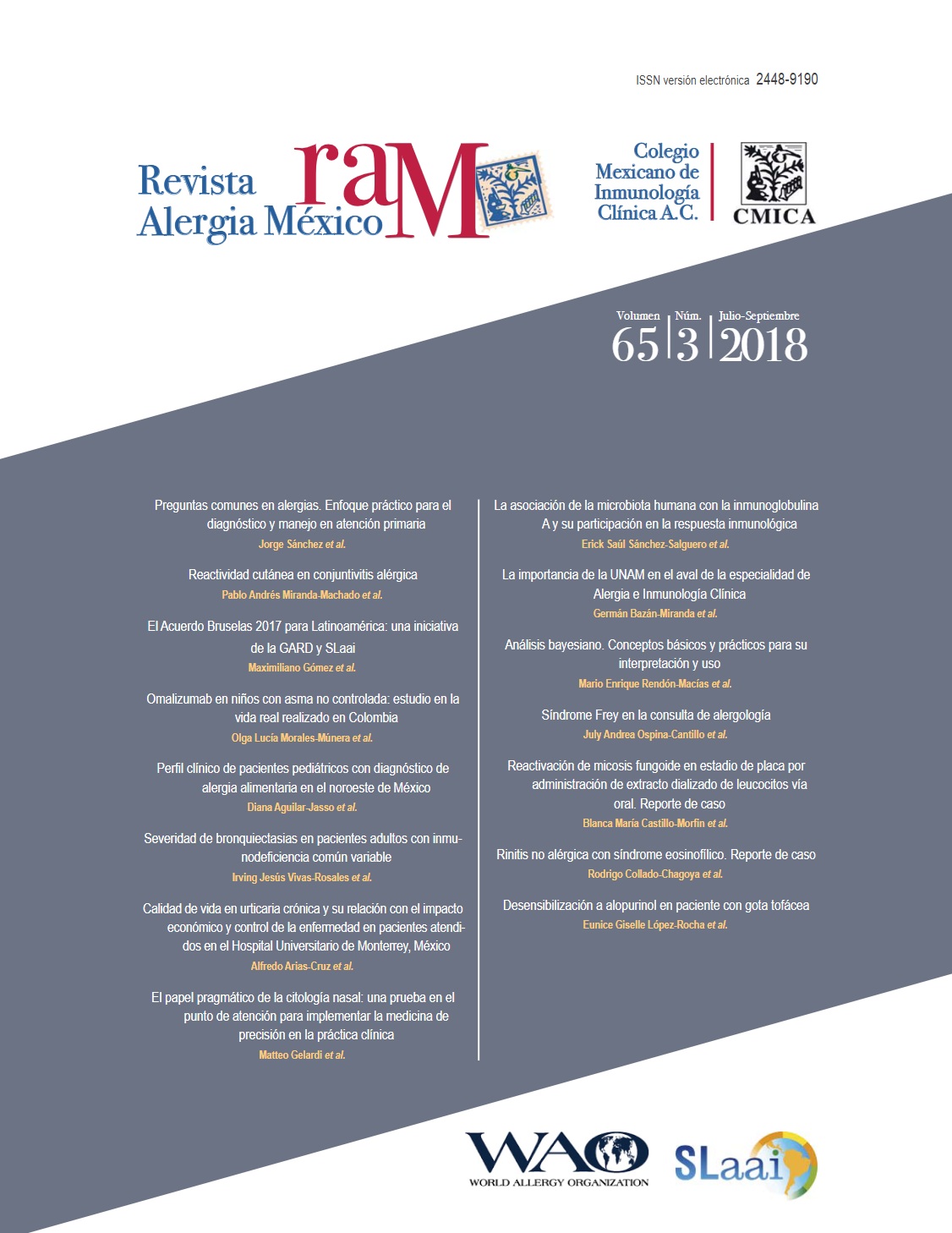Resumen
Antecedentes: La rinitis es la primera causa de consulta en el servicio de alergia. Se trata de una inflamación crónica de la mucosa nasal. La rinitis no alérgica con síndrome eosinofílico se caracteriza por eosinofilia crónica (> 20 % de eosinófilos en citología nasal) sin que pueda comprobarse la existencia de alergia (pruebas in vivo e in vitro negativas); frecuentemente se acompaña de otras enfermedades sinonasales (poliposis nasal, rinosinusitis crónica) y constituye un factor de riesgo para desarrollar apnea obstructiva del sueño.
Caso clínico: Niña de siete años de edad con rinorrea, obstrucción nasal, prurito nasopalatino y estornudos de intensidad severa que limitaban sueño y actividades escolares, de patrón estacional con importante eosinofilia sanguínea (800 eosinófilos/μL) y nasal (30 %), sin alergia demostrable (pruebas cutáneas negativas y pruebas de provocación nasal específicas negativas); se comprobó el diagnóstico de rinitis no alérgica con síndrome eosinofílico.
Conclusiones: La rinitis no alérgica con síndrome eosinofílico se considera una enfermedad altamente infradiagnosticada debido a la falta de realización de pruebas nasales in vivo. A la infravaloración se suma la incorrecta etiología nasal y la inexistencia de pruebas in vitro locales (IgE nasal específica), por lo que amerita un alto grado de sospecha diagnóstica por parte del médico especialista.
Referencias
Bousquet J, van Cauwenberge P, Allergic RHINITIS and Its Impact on Asthma (ARIA). Ginebra, Suiza: WHO; 2008.
Strachan D, Sibbald B, Weiland S, Aït-Khaled N, Anabwani G, Anderson HR, et al. Worldwide variations in prevalence of symptoms of allergic rhinoconjunctivitis in children: The International Study of Asthma and Allergies in Childhood (ISAAC). Pediatr Allergy Immunol. 1997;8(4):161-176. DOI: 10.1111/j.1399-3038.1997.tb00156.x
Larenas-Larenas D, Mayorga-Butrón JL, Sánchez-González A, Ramírez-García A, Medina-Ávalos MA, Figueroa-Morales MA, et al. ARIA México 2014. Metodología ADAPTE. Rev Alerg Mex. 2014;61 Supl 1:S3-S116. DOI: 10.29262/ram.v61i0.52
Papadopoulos NG, Bernstein JA, Demoly P, Dykewicz M, Fokkens W, Hellings PW, et al. Phenotypes and endotypes of rhinitis and their impact on management: a PRACTALL report. Allergy. 2015;70(5):474-494. DOI: 10.1111/all.12573
Ellis AK, Keith PK. Nonallergic rhinitis with eosinophilia syndrome. Curr Allergy Asthma Rep. 2006;6(3):215-220.
Jacobs RL, Freedman PM, Boswell RN. Nonallergic rhinitis with eosinophilia (NARES syndrome). Clinical and immunologic presentation. J Allergy Clin Immunol. 1981;67(4):253-262. Disponible en: https://www.jacionline.org/article/0091-6749(81)90019-1/pdf
Moneret-Vautrin DA, Hsieh V, Wayoff M, Guyot JL, Mouton C, Maria Y. Nonallergic rhinitis with eosinophilia syndrome a precursor of the triad: nasal polyposis, intrinsic asthma, and intoleranceto aspirin. Ann Allergy. 1990;64(6):513-518.
Kramer MF, De-La-Chaux R, Fintelmann R, Rasp G. NARES: a risk factor for obstructive sleep apnea? Am J Otolaryngol. 2004;25(3):173-177. DOI: 10.1016/j.amjoto.2003.12.004
Leone C, Teodoro C, Pelucchi A, Mastropasqua B, Cavigioli G, Marazzini L, et al. Bronchial responsiveness and airway inflammation in patients with nonallergic rhinitis with eosinophilia syndrome. J Allergy Clin Immunol. 1997;100(6 Pt 1):775-780. DOI: 10.1016/S0091-6749(97)70273-2
Gelardi M, Maselli-Del-Giudice A, Fiorella ML, Fiorella R, Russo C, Soleti P, et al. Non-allergic rhinitis with eosinophils and mast cells constitutes a new severe nasal disorder. Int J Immunopathol Pharmacol. 2008;21(2):325-331. DOI: 10.1177/039463200802100209
Moneret-Vautrin DA, Jankowski R, Wayoff M. Clinical and pathogenic aspects of NARES (non-allergic rhinitis with eosinophilic syndrome). Rev Laryngol Otol Rhinol (Bord). 1991;112(1):41-44.
Becker S, Rasp J, Eder K, Berghaus A, Kramer MF, Gröger M. Non-allergic rhinitis with eosinophilia syndrome is not associated with local production of specific IgE in nasal mucosa. Eur Arch Otorhinolaryngol. 2016;273(6):1469-1475. DOI: 10.1007/s00405-015-3769-4
Sonawane R, Ahire N, Patil S, Korde A. Study of eosinophil count in nasal and blood smear in allergic respiratory diseases. MVP J Med Sci. 2016;3(1):44-51.
Schiavano D, Nucera E, Milani A, Della-Corte AM, D’Ambrosio C, Pagliari G, et al. Nasal lavage cytometry in the diagnosis of nonallergic rhinitis with eosinophilia syndrome (NARES). Allergy Asthma Proc. 1997;18(6):363-366.
Crobach M, Hermans J, Kaptein A, Ridderikhoff J, Mulder J. Nasal smear eosinophilia for the diagnosis of allergic rhinitis and eosinophilic non-allergic rhinitis. Scand J Prim Health Care. 1996;14(2):116-121.
Klimek L, Rasp G: Norm values for eosinophil cationic protein in nasal secretions: influence of specimen collection. Clin Exp Allergy. 1999;29(3):367-374. DOI: 10.1046/j.1365-2222.1999.00494.x
Settipane RA, Lieberman P. Update on nonallergic rhinitis. Ann Allergy Asthma Immunol. 2001;86(5):494-507. DOI: 10.1016/S1081-1206(10)62896-7
Purello-D’Ambrosio F, Isola S, Ricciardi L, Gangemi S, Barresi L, Bagnato GF. A controlled study on the effectiveness of loratadine in combination with flunisolide in the treatment of nonallergic rhinitis with eosinophilia (NARES). Clin Exp Allergy. 1999;29(8):1143-1147. DOI: 10.1046/j.1365-2222.1999.00598.x
Bachert C, Watelet JB, Gevaert P, Van-Cauwenberge P. Pharmacological management of nasal polyposis. Drugs. 2005;65(11):1537-1552.
Saito H, Morikawa H, Howie K, Crawford L, Baatjes AJ, Cyr MM, et al. Effects of a cysteinyl leukotriene receptor antagonist on eosinophil recruitment in experimental allergic rhinitis. Immunology. 2004;113(2):246-252. DOI: 10.1111/j.1365-2567.2004.01944.x
Kramer MF, Rasp G. Nasal polyposis: eosinophils and interleukin-5. Allergy. 1999;54(7):669-680. DOI: 10.1034/j.1398-9995.1999.00095.x

Esta obra está bajo una licencia internacional Creative Commons Atribución-NoComercial 4.0.
Derechos de autor 2018 Revista Alergia México

